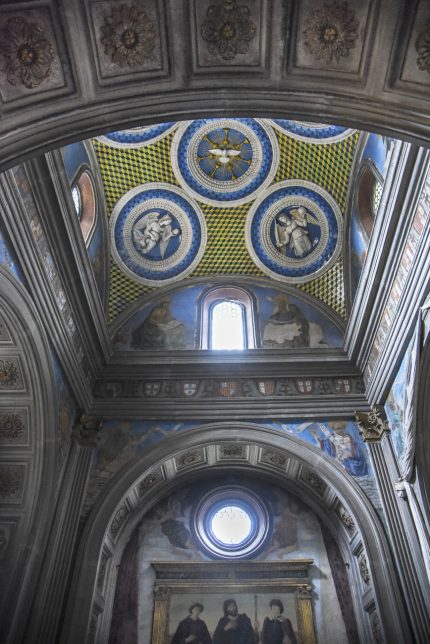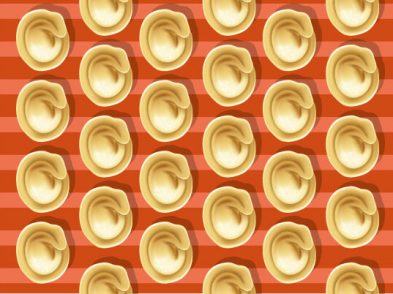The basilica of San Miniato al Monte recently celebrated its 1,000th birthday. Dominating the view from one of the highest and most scenic spots overlooking Florence, it is a jewel of Tuscan Romanesque architecture. A defensive wall built in haste by Michelangelo during the siege of Florence in 1530 surrounds the church complex, later completed by Cosimo I de’ Medici and made into a real fortress in 1553. Today, enclosed within that wall is the Porte Sante monumental cemetery where many famous Italians are buried, amongst others, Carlo Collodi, who created Pinocchio, painter Pietro Annigoni and politician Giovanni Spadolini. By contrast, inside the church—although the basilica’s simplicity and elegance are striking and it proves to be a trove of artistic treasures that make the steep walk up the many steps more than worth the effort—we find only one tomb, that of a noble churchman from a distant land.

Ph. Marco Badiani
On the side of the left aisle, the Chapel of the Cardinal of Portugal was commissioned by the King of Portugal, Alfonso V (1432–81), and built between 1461 and 1466. Known as “the African” because of his conquests in the north of the continent, the king had the chapel erected to house the tomb of his nephew, James of Lusitania, Cardinal of Portugal, who unexpectedly fell ill and died in Florence while travelling from Rome to Mantua in late August 1459. Only 26 years old, James, on his deathbed, had expressed the desire to be buried there.
Praised by contemporaries as a pious man, James studied in Flanders and, in 1453, became Bishop of Arras in France. That same year, Pope Nicholas V appointed him Archbishop of Lisbon but, as he was still too young to take on those duties, he was initially appointed administrator in perpetuity of the archdiocese. Because of political upheaval in Portugal, he was unable to return to Lisbon so, remaining in Italy, he governed his archdiocese from a distance. Following the death of Nicholas V in 1455, the new pope, Callixtus III, raised James to the position of a cardinal-deacon of the Church firstly at the diaconate of Santa Maria in Portico Octaviae and then at Sant’Eustachio in Rome. Soon after, the Pope named him Bishop of Paphos, in Cyprus, where his brother John had married a princess. On the death of Callixtus III, James had taken part in the conclave that elected Pius II as the new pope and, in 1456, was appointed a Knight of the Order of the Golden Fleece, in The Hague.
A masterpiece of the Florentine Renaissance, the chapel reflects the fertile collaboration between architects, artists and sculptors and their workshops, and encompasses a wide range of different techniques that produced unique and stunning results. The original design was by Antonio Manetti, a student of Brunelleschi, but because he died a year after James the project was handed over to Giovanni Rossellini for its construction and, for the sculptures, his brother Antonio Rossellino, whom Vasari described as “a most excellent, indeed marvellous, maestro in sculpture who was highly respected whilst alive and very famous after his death”. Square in shape with arched recesses on each side, the chapel is entered through one of the four arches. The cardinal’s tomb, with its sarcophagus mounted by a full-length effigy of the deceased dressed in his cardinal’s mitre and an elaborate dalmatic befitting his station, was the work of Antonio Rossellino. The porphyry backdrop behind the tomb, which was once decorated in gold, and the figures in white marble reminds us of his royal lineage. Above it, there is a tondo of the Madonna and Child surrounded by four angels, whilst, below it, the base is decorated with an intricate symbolic frieze and a Latin inscription dedicated to the cardinal. The drape on which the cardinal’s body lies is held on each side by two precariously seated “putti”.
There is a marble throne opposite the tomb that also exhibits the cardinal’s royal lineage, which was probably sculpted by Bernardo, another Rossellini brother. Behind it is a beautiful Annunciation by Alesso Baldovinetti. Other series of frescoes by Baldovinetti can be seen in the lunettes and include the eight Prophets, the four Evangelists and the four Doctors of the Church.
Facing the chapel’s entrance, the altarpiece was painted on wood by two other brothers, Antonio and Piero del Pollaiolo, and depicts the saints Vincent (patron saint of Lisbon), James (the cardinal’s name saint) and Eustace (patron of the one of the cardinal’s churches). The painting now in San Miniato is a copy as the original was moved to the Uffizi in 1800. Another two angels hold back the drapes in the lunette above the altarpiece.
Stefano di Bartolommeo’s ornate geometrical flooring is in the cosmatesque style typical of Romanesque pavements, being an opus sectile mosaic that uses semi-precious stones and white Carrara marble pieces of different sizes.
Finally, Luca della Robbia’s extraordinary glazed terracotta ceiling depicts the four cardinal virtues (Temperance, Prudence, Justice and Fortitude) in tondos in the corners, with the dove of the Holy Spirit in the middle surrounded by seven candlestick holders, symbols of the seven-branched menorah of Judaic tradition.








